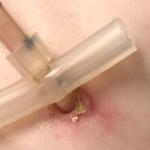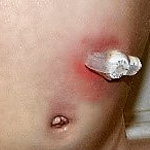G, GJ, J Tube Complications Clinical Pathway — Inpatient
G, GJ, J Tube Complications Clinical Pathway — Inpatient
Erythema
Erythema (redness) of the peristomal skin is common and can be caused by a variety of reasons. The cause must be determined to prevent harm. Document the site with images in Epic Media tab. The table below outlines common causes.
Erythema Around Atoma
| Potential Source | Recommended Approach | Comments |
|---|---|---|
| Tube fit is too tight or too loose |
|
|
| Leaking | ||
| Stoma granulation tissue | ||
| Drainage onto skin |
|
|
| Irritant dermatitis |
|
|
| Cellulitis |
|
|
Examples of Erythema


Following Bedside Treatments
Monitor site and reassess. Allow at least 3 days for the redness to improve.
If erythema worsens or does not improve after 2-3 days, contact the FLOC on the appropriate service for further assessment.